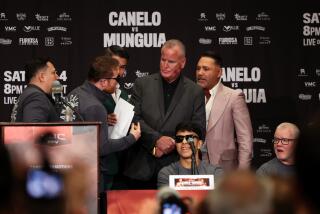Sometimes, Boxing Numbers Don’t Add Up
- Share via
For nearly two decades, people have taken them for granted. Compubox numbers are routinely displayed on boxing telecasts, referred to in newspaper stories and repeated around water coolers all over the country the day after a big fight. They are cited time and again as evidence this fighter had an effective jab or that fighter had devastating power.
Then came last month’s rematch between Oscar De La Hoya and Shane Mosley. And all of a sudden, there was doubt and there were questions: What is Compubox? Who runs it? How do they operate? Who pays them?
The doubt sprung from the disparity between the Compubox numbers and the judges’ numbers. All three judges gave the super-welterweight title fight to Mosley, 115-113. Yet, according to Compubox, De La Hoya connected on 36% of his punches, to 26% for Mosley. And De La Hoya had dominated Mosley, according to Compubox, in both jabs landed, 106-33, and power punches, 115-94.
Why the big difference?
“We always said there is a 2% margin of error,” said Bob Canobbio, one of the co-inventors of Compubox. “It was never designed to score fights. We never said that. It’s quantitative, not qualitative. It’s designed to show a fighter’s output. Nine times out of 10, the guy who throws and lands more punches wins the fight. It just so happens, it didn’t work out in De La Hoya-Mosley. Or the following week, for that matter [when International Boxing Federation champion Chris Byrd won a decision over Fres Oquendo, despite having lagged in the Compubox numbers].”
In 1984, Canobbio was working as a researcher for Sports Illustrated and Logan Hobson was a correspondent for United Press International. Hired to compile a database on boxing, they expanded the idea and came up with Compubox.
The concept is simple. Two men sit side by side on press row, one for each fighter and each pressing buttons on an electronic device that counts punches, power punches and jabs, both the number thrown and landed.
Hobson, who has since left the company, and Canobbio struck it rich immediately, landing a deal with HBO in 1985. The operation has expanded, Compubox now doing around 60 shows a year, but the technology has remained unchanged -- and, in some quarters, unaccepted.
“No human alive can hit numbers fast enough to get all the punches,” said Gary Shaw, Mosley’s promoter.
“We’ve been doing this for 18 years,” Canobbio said, “and all of a sudden, we can’t keep up?”
Shaw has another criticism.
“The Compubox guys are only sitting on one side of the ring,” he said. “If a fighter’s back is to them and a punch is thrown at that fighter, how can the Compubox guy tell if it did any damage? It is ludicrous to judge by Compubox. That’s why the judges sit on three sides.”
Chuck Giampa, who has been a judge for 19 years, would like to see three teams of Compubox operators, one behind each judge.
“Then,” he said, “let’s compare and see if they agree with the judges or even with each other. I bet they won’t. Compubox is good for TV, but it’s a gimmick.”
Has HBO itself been lured into putting too much reliance on Compubox?
“I think everybody else did,” said Ross Greenburg, president of HBO Sports. “We never did. We took it for what it was. And we will continue to use it because it still has statistical merit.”
More to Read
Go beyond the scoreboard
Get the latest on L.A.'s teams in the daily Sports Report newsletter.
You may occasionally receive promotional content from the Los Angeles Times.










